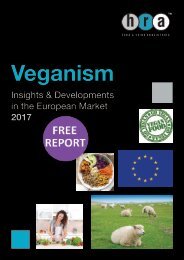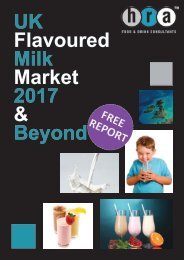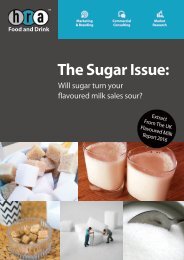European Lactose-Free Market Report 2017/2018 Report
Dying to know what’s going on in the hottest Free From category? Looking for something different to those tedious reports filled with nothing but data and no insight? Looking for detailed category analysis from experienced specialists to give your brand the ‘Edge’?
Dying to know what’s going on in the hottest Free From category?
Looking for something different to those tedious reports filled with nothing but data and no insight?
Looking for detailed category analysis from experienced specialists to give your brand the ‘Edge’?
Create successful ePaper yourself
Turn your PDF publications into a flip-book with our unique Google optimized e-Paper software.
1.3 MANAGING LACTOSE INTOLERANCE<br />
THE EUROPEAN LACTOSE-FREE MARKET <strong>2017</strong>/<strong>2018</strong><br />
The recommended way to manage lactose intolerance is to avoid lactose containing<br />
foods. <strong>Lactose</strong> is the main carbohydrate in milk derived from mammals including cows,<br />
sheep & goats (see below). Human breast-milk also contains lactose.<br />
Foods containing lactose:<br />
Ø Milk<br />
Ø Yoghurt<br />
Ø Cheeses<br />
Ø Butter<br />
Ø Cream<br />
Ø Ice cream<br />
Other products may contain whey or curds<br />
derived from dairy, including biscuits,<br />
bread, sauces and meats.<br />
To view, please download FULL <strong>Report</strong><br />
1.3.1 LACTOSE CONTENT OF DIFFERENT DAIRY PRODUCTS<br />
Grams lactose per<br />
100g<br />
5<br />
4<br />
3<br />
2<br />
1<br />
0<br />
4.5<br />
2.5 2.3 0.7<br />
Whole milk Yoghurt Soft cheese Hard cheese<br />
Dairy product<br />
Figure 1.1: <strong>Lactose</strong> content in different dairy products 3<br />
§ Different dairy products contain varying levels of lactose. Whole milk contains the<br />
highest concentrations of lactose, whilst hard cheeses contain the least.<br />
§ Cheeses such as parmesan, contain virtually no lactose, so can be eaten by some<br />
people with from lactose intolerance. This is because the enzymes used in the<br />
production of such cheeses convert lactose into lactic acid prior to human<br />
consumption.<br />
All rights reserved, ©Teepee Ltd, t/a HRA Food & Drink: <strong>2017</strong> 6







